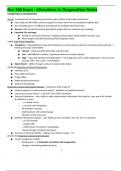Other
Nur 260 Exam : Alterations In Oxygenation Notes University of Notre Dame
- Module
- NURS 260 (NUR260)
- Institution
- Abacus College, Oxford
Nur 260 Exam : Alterations In Oxygenation Notes University of Notre Dame/Nur 260 Exam : Alterations In Oxygenation Notes University of Notre Dame
[Show more]



